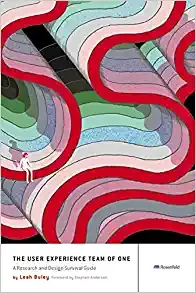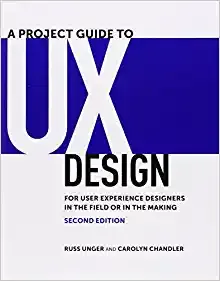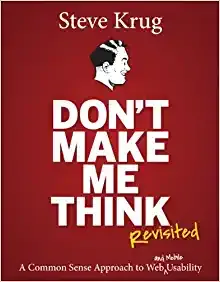Welcome to an insightful journey through the '15 Best UX design books for beginners,' written by Muhiuddin Alam on the book recommendations and reviews site, ReadingAndThinking.com.
I have received many requests to recommend some of the UX design books for beginners. In response, I'm pleased to offer my expert recommendations in this article.
So, when I suggest these books, it's because I've read a lot and want to share the best ones with you. I'm all about making your reading experience awesome. Trust in a guide deeply immersed in the literary books and stories. I love books just like you do!
I will recommend you best UX design books for beginners in this post, which is based on my in-depth study and testing in this field. Such as The User Experience Team of One, Designing for Interaction, A Project Guide to UX Design, The Design of Everyday Things, and How to Get Started with CRO.
These aren't the only books on this topic. Below, you'll find 15 books with detailed descriptions of each of these outstanding resources, helping you make well-informed decisions to choose UX design for beginners.

15 Essential UX Design Books for Beginners to Read in 2024
With these UX design books, you can continue your UX learning and expand your skills.
Ready to learn more about interaction design with these best books for learning UX design?
Reading books written by experts in your field can give you valuable insights. This is especially true when you are choosing a good UX design book!
If you're looking for deeper knowledge about UX design, check out these 15 best books for learning UX design that will help you reach new heights in your career. You'll find practical advice on everything from designing interfaces, designing systems, usability testing, how to create engaging content, and persuasive copywriting techniques in a digital world.
They're all written by experts who have worked in the field for years, so they really know what they're talking about when it comes to creating a positive user experience online.
Keep reading to find the best UX design books for beginners to improve your UX skills (or get started in UX design).
1. The User Experience Team of One
The User Experience Team of One: A Research and Design Survival Guide by Leah Buley
The UX Generalist is a book that helps you understand how to do UX design work and gives practical advice on how to maximize your successful outcomes with limited resources.
It is important to understand how much UX work one person can accomplish. This UX book will help you gain a deeper understanding of UX and improve your leadership skills.
One of the best UX books I've read on UX design is The UX Generalist by Leah Bray. This UX book provides practical advice, guidelines, and visual cases for UX designers working in small businesses or startups, the only designer in an enterprise, or their only employee responsible for UX design.
I highly recommend this UX design book because it tells an inspiring story with well-studied statistics and a list of tools that UX designers can use.
Bray's work is highly readable and an engaging book. It will give you a good basic idea of what UX is and how it works in the field. This book is also helpful for those who want to know more about how design can fit into the world of UX design.
2. Designing for Interaction
Designing for Interaction: Creating Innovative Applications and Devices (Voices That Matter) by Dan Saffer
Dan in his book provides readers with a deep understanding of interaction design, which is of great practical value to scholars entering the field of interaction design.
This book can help you learn to develop design strategies, use design research to gain insight into people's behaviors, motivations, and goals, as well as learn to use brainstorming to create product solutions and understand the processes and methods that define product behavior. It is suitable for students who are beginner interaction designers.
Dan Saffer defines interaction design as the art of facilitating interaction between people through products and services, combining chaotic design into an understandable, orderly reference, while the book introduces the world around us,
and The interactions we experience every day; his book opens up the world of design and presents it in an accessible way, creating usable products and design strategies, offering a fresh perspective in the field of interaction design. This is a must-have book for anyone looking to create new designs.
3. A Project Guide to UX Design
A Project Guide to UX Design: For user experience designers in the field or in the making (Voices That Matter) by Russ Unger
Suitable for designers currently working as UX designers or planning to enter the UX field.
This book is an essential reference for UX designers, covering various topics related to UX design, including user models, user-centered design, user testing, wireframing, and prototyping. Whether an entrepreneur, a project manager, or a user experience designer, this book could be a reference.
" If you're a young designer entering or planning to enter the UX field, this is a classic book. If you're an organization that really needs to get started with UX, this book is also for you."
—Chris Bernard, User Experience Evangelist, Microsoft
4. The Design of Everyday Things
The Design of Everyday Things: Revised and Expanded Edition by Don Norman
This book is not much to introduce, it is a must-read classic book. This book explains how to think about designing for users. Only by recognizing the bad design of life can we learn to interact better, starting from people's own needs.
By sorting out the problems and products that people may find difficult to do in daily life, as well as the design of products that feel complicated to use, it is proposed to fully consider product visibility, product feedback, and product design when designing products.
It should be as simple as possible, consider human errors and other related viewpoints; when conceiving a product, first put yourself in the user's shoes imagine the user's feelings, and adhere to the people-oriented design concept.
5. How to get started with CRO
How to get started with CRO: Workbook & Insights by Alexander Rådahl Ahlsen
Most guides are either too long, too short or have too many outlines to actually help you at all.
There is a free workbook that will help you create your own CRO success plan and show you how other companies have done it successfully, what went wrong in their strategy, and how to learn from them.
This book is free because I believe knowledge should be shared! This book has helped several companies.
6. Rocket Surgery Made Easy
Rocket Surgery Made Easy: The Do-It-Yourself Guide to Finding and Fixing Usability Problems by Steve Krug
Steve Krug's last book, Don't make me think, has almost become a must-have book for website interaction designers or related workers.
Nine years later, this new book, "Rocket Surgery Made Easy: The Do-It-Yourself Guide to Finding and Fixing Usability Problems", can be seen from the title of the book's content and positioning (assuming you are Usability and usability issues already have some or more awareness).
Steve continues to use his signature colloquial, conversational, and short and concise writing style, covering everything from usability lab setup, test task design, and test moderator to test result analysis and communication in 150 pages.
Of course, in this book, Steve mainly introduces the "Discount Usability Engineering" advocated by Jakob Nielsen, that is, everyone can do usability testing, but it does not necessarily require more skills and experience. High professional skills such as quantitative testing, comparative testing, and testing of new technologies (which are barely covered in this book).
This book is still suitable for website interaction designers (or other interaction product designers), and it takes only a small amount of time to get a good grasp of basic usability testing, as Steve advocates "one per month" "Morning" testing will definitely keep the project at hand agile and efficient development progress. Likewise, usability testing professionals can be inspired by this book, which incorporates Steve's own longstanding experience in usability consulting and speaking
7. Sprint
Sprint: How to Solve Big Problems and Test New Ideas in Just Five Days by Jake Knapp
In the past few months, I have been doing research. After doing it for a while, I couldn’t move forward. I realized that I have encountered a bottleneck: I found a problem or demand point, how can I convert it into a product or service, and then generate revenue Creating value has become a new problem.
So I decided to put down what I was doing for a while, and reflect for a while: Is it enough to think deeply about the problem, is there a clear approach to help me realize the idea, and what am I wondering about.
It was at this time that I discovered Sprint. It proposes a very bold approach, just as the word Sprint means: quickly solve a problem in five days, design and develop a new product and complete the test to summarize. It's so exciting to think about how it's possible.
The author of the book, Jake Knapp, was originally a Googler and an advocate and practitioner of optimizing workflow's problem-solving methodology, aka Sprint, which is widely used within Google. Later, he entered Google Venture (GV), and through Sprint, he helped start-ups to better organize their ideas, practice their ideas, and solve difficult problems.
Sprint provides a complete set of actionable approaches, step by step, which is the thought pattern of this breakthrough innovation. In the whole process, the use of time management and tools is particularly important, and pressure has also become a kind of motivation.
The cases used in the book are all successful cases of GV through Sprint practice. In these practices, Sprint is constantly being optimized, and finally, the content presented in this book is formed.
What struck me the most about this book was the way of thinking and methodology used by Sprint. The way of thinking is positive and result-oriented, that is, set long-term & short-term goals and start at the end mentioned in the book. At the same time, it is necessary to put it down and form a product or service.
The methodology is innovative. Sprint helps an organization step by step to clarify ideas, form teams, set goals, grasp the main contradictions, propose solutions, test, summarize, and then implement them, and even refine them to the needs of each process. The tools, and considerately at the end of the book, provide a checklist (shopping list), and a more detailed introduction on Sprint's official website.
This is a very useful book. It can not be said to be subversive, but also innovative. It refreshed my thinking, and the things to do are not so difficult.
PS: I also read another "Deep Work" at the same time, which is recommended.
8. Interviewing Users
Interviewing Users: How to Uncover Compelling Insights by Steve Portigal
In the age of experience design, everything is centered on user experience. In order to do all this well, you must understand the users. As the most commonly used research method in user research, the importance of user interviews is self-evident.
This book describes the author's user interview methods and tips in detail, from setting goals to recruiting interviewees and creating interview guidelines...
The author not only discusses with us the technical issues of user interviews, but also tells us how to deal with them Various unexpected times and methods of interpersonal communication can be described as comprehensive, and the details are also in place.
I believe that after reading this book, with more practical exercises, everyone can become an expert in user interviews and make their own products well! !!
9. Web Form Design: Filling in the Blanks
Web Form Design: Filling in the Blanks by Luke Wroblewski
I have learned a lot from reading the whole book, and looking at the summaries of predecessors can really save a lot of effort in trying and groping.
I have learned a lot, and the deep impression is that the author did not directly give a conclusion on which design is better, but through the experimental results and analysis, showed the advantages and disadvantages of different designs, and finally came to a specific analysis of specific things. in conclusion.
In fact, after reading it, it is still inseparable from your own attempts, don't stand still, there may be better ways. Perhaps this is the book's greatest revelation?
The author explained the advantages and disadvantages of various designs with various forms, he kept mentioning the colors used in the sample forms.
A book can be written about the design of forms. It can be seen that it is not a matter of a few words to explain what a good form design is. Human-computer interaction through forms consumes a lot of brain cells, so I look at form design from the following three cost perspectives:
1. Reduce visual costs
- Have clear browsing lines, which are convenient for scanning;
- Through background color, Horizontal lines and spacing groups form content
- Paranoia reduces visual distraction
2. Reduces cognitive cost
- Carefully design label alignment
- Reasonably group questions
- Indicate by input box length
- Effectively indicate required fields Items or optional items (optional)
- Provide help in a timely manner
3. Reduce interaction costs and risks
- Support Tab key jump
- Distinguish active actions from secondary actions (such as submit and cancel)
- Actions in progress must be Given feedback (like committing...)
- Give hints about where things go wrong
- Clear success hints and follow-up
- Smart defaults
- Smart suggestions
- Provide instant verification
- Highlight
- When inputting the currently activated form component, reduce the switching between the keyboard and the mouse.
In fact, in addition to the above, the most important basic skill is to have a deep understanding of the purpose and usage scenarios of each form control. Forms that people can easily interact with.
10. Lean UX: Applying Lean Principles to Improve User Experience
Lean UX: Applying Lean Principles to Improve User Experience by Jeff Gothelf
The UX field is constantly changing, and UX designers are always looking for new skills to learn. UX designers must be constantly learning and curious about the design process.
UX designers must be more agile and improve the design process. In Lean Design: How Design Teams Can Improve User Experience, you'll gain a way of thinking about how to build user-friendly products that meet the needs of your business.
Lean UX: Applying Lean Principles to Improve User Experience by Jeff Gothelf and Seddon is an excellent learning resource for successful design. Readers will learn how to create the minimum viable product and drive their sales business to success. If you want to improve your design skills, this is a good start.
Lean UX: Designing Great Products with Agile Teams,
by Jeff Gothelf and Josh Seddon, is an effective guide for all designers who want to create the best possible experience. The benefit of this book is to help learn new ways to build products. Teachings in this book contain cases, case studies, and information on how different companies apply actual iterative products to the design process.
By reading this book, you will be more focused on understanding the problem and brainstorming solutions with the team throughout the development process. This gives you the opportunity to share insights with the team early in the design process, create a minimal viable product, demonstrate what ideas are working, and aggregate client input throughout the project cycle.
Lean Design: How Design Teams Can Improve User Experience is a book that not only provides guidelines for conducting user research but can also be used to identify organizational changes in a company.
Adam Fard is the founder and design lead of his own UX design agency. He told me that when he first read the book, he first realized what design was all about.
He also said:
—Adam Farder
11. Don't Make Me Think, Revisited
Don't Make Me Think, Revisited: A Common Sense Approach to Web Usability by Steve Krug
This book is for anyone to read, not a purely technical book. Although the time is relatively early, the first edition was published in 2006, but the design principles advocated by this book have not changed.
This book provides many vivid cases. According to the characteristics of users browsing the web, it proposes clear and easy-to-use website design principles, such as navigation, tabs, how to design the home page, and usability testing methods and examples.
All in all, this book clearly teaches beginners how to design with usability in mind and avoid making your users think too much about how your product will be used.
12. 100 Things Every Designer Needs to Know About People
100 Things Every Designer Needs to Know About People by Ph.D. Weinschenk, Susan
Susan Weinshank's book Psychology for Designers lays out cognitive biases, emotional triggers, and decision shortcuts that influence our everyday behavior.
You'll learn what attracts people to the design and how they react when presented with a different interface or layout. This book is for designers, so you can create more intuitive and user-friendly apps based on these results!
The authors discuss how people differ in many ways, from their need for novelty to how they react when things go wrong. The book then explains these different needs and responses that can influence design decisions at every level: whether designers create experiences or products; whether they create physical space, content, or visual interface.
Using the latest neuroscience research, Susan Weinshank tells readers about her journey of discovery and how she uses it to design. She teaches audiences how to inspire people from all walks of life by speaking at various conferences around the world.
This book is a must-read for designers as it helps them create more user-friendly interfaces. In the introduction, author Susan Weinshank writes about the differences between people and how they should be taken into account when designing.
Designers need to understand how their users react to certain layouts or design concepts to ensure that the interfaces they create work well for everyone! If you find yourself stuck in the middle of a project, this handy guide contains plenty of advice to do.
Susan Weinshank's Psychology for Designers provides readers with a checklist of cognitive biases, emotional triggers, and decision-making shortcuts that influence our everyday behavior.
Not only does it give you tips on handling design challenges, but it also explains how to make everyday decisions in an easy-to-understand way. From persuasion strategies to detection methods, author Susan offers a lot of helpful advice in her book, so we as designers can make more informed decisions when creating new digital experiences or improving existing ones.
13. Just Enough Research
Just Enough Research by Erika Hall
I'm so excited to read the book "Enough Research is Enough" by Erica Hall. She is one of the founders of the design firm Mule Design, and in this concise book, she teaches you how to do basic user research. You'll learn about interviews, situational research, participatory design, anthropological research, and more - all kinds of stuff!
This book is not just a great designer's toolbox, it's a method for those new to the field to learn different user research methods! The whole point of this book is that it gives designers (whether they are beginners or not) all the information to do user research (interaction design, UX research).
Erica has carefully written these practical recommendations with years of experience: From the design of surveys and interviews to feedback loops and the use of qualitative data (including observations), to an understanding of immersive technologies, including video journaling—whatever you Everything you can think of!
14. Observing the User Experience
Observing the User Experience: A Practitioner's Guide to User Research by Elizabeth Goodman Ph.D. School of Information University of California Berkeley
This book is an excellent learning resource for all designers who want to develop better products. The author offers 13 ways to make your designs more engaging and interactive, all practical ways to bridge the gap between designers and users. These tips are simple, and no matter what objective constraints your work has - tight budgets or time constraints, nothing will prevent these methods from being successful!
The new edition of the book includes updated sections on the observational study, the mobile usability study, and the diary study. I found the section on remote research projects fascinating - it focuses on cross-cultural and multilingual projects.
The authors of this book, Elizabeth Goodman, Mike Kunevsky, and Andry Maude, provide a quick-start guide to user research. In addition to providing practical advice for designers, this book also creates a bridge between designers and users by looking at what users want and need. This is an excellent working guide for designers who may not be familiar with user research.
15. Hooked: How to Build Habit-Forming Products
Hooked: How to Build Habit-Forming Products by Nir Eyal
The book "HOOKED" summarizes the common characteristics of users' dependence on products, reveals the basic design principles behind Internet products and services that can make people "Hooked", and concludes that in order to develop user habits, triggers, and actions are needed. , variable rewards, and four stages of investment.
In this way, we can create a highly sustainable and highly disseminated product. It is strongly recommended for product managers, designers, marketing and sales personnel, advertising creatives, and other users to read deeply. This book will also give you a deeper understanding of yourself and the currently popular products and firmly grasp the user's Hooked psychology.
Let users become their own loyal customers, and then achieve the ultimate goal of circular consumption, stimulate the market economic situation, and occupy a place in the context of the Internet economy.
One book that’s held up really well not only as a reference for designers but as a great source of insight into design trends for non-designers is Hooked: How to Build Habit-Forming Products by Nir Eyal. The core insight here is that good UX design goes beyond making a product easy to use and into making it rewarding to use.
--- Devin Fatta





















